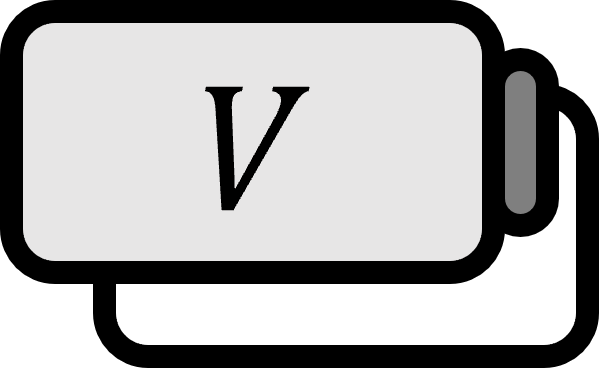二次形式
定義
$V$を$n$次元のベクトル空間と呼ぶ。与えられた定数$a_{ij} \in \mathbb{R}(\text{or } \mathbb{C})$について、以下の2次斉次関数$A : V \to \mathbb{R}(\text{or } \mathbb{C})$を二次形式という。
$$ A(\mathbf{x}) := \sum\limits_{i,j=1}^{n} a_{ij}x_{i}x_{j},\qquad (a_{ij} = a_{ji}) $$
この時、$\mathbf{x} = \begin{bmatrix} x_{1} & \cdots & x_{n} \end{bmatrix}^{T}$である。$i \ne j$に対する$a_{ij}x_{i}x_{j}$を混合項という。
説明
定義によると、$A(\lambda \mathbf{x}) = \lambda^{2} A(\mathbf{x})$が成り立つ。
行列形
$A$を$n\times n$対称行列$A = \begin{bmatrix} a_{ij} \end{bmatrix}$とする。行列$A$に対する二次形式を、Quadraticの頭文字を取って、$Q_{A}(\mathbf{x})$と表記し、$A$に関連する二次形式と呼ぶ。
$$ Q_{A}(\mathbf{x}) = \mathbf{x}^{T}A\mathbf{x} =\begin{bmatrix} x_{1} & \cdots &x_{n} \end{bmatrix} \begin{bmatrix} a_{11} & \cdots & a_{1n} \\ \vdots & \ddots & \vdots \\ a_{n1} & \cdots & a_{nn} \end{bmatrix} \begin{bmatrix} x_{1} \\ \vdots \\ x_{n} \end{bmatrix}=\sum \limits _{i=1} ^{n}\sum \limits _{j=1} ^{n}a_{ij}x_{i}x_{j} $$
例えば、$\mathbb{R}^{2}$上の二次形式は以下の通り。
$$ \begin{align*} & a_{11}^{\ }x_{1}^{2} + a_{22}^{\ }x_{2}^{2} + a_{12}^{\ }x_{1}^{\ }x_{2}^{\ } + a_{21}^{\ }x_{2}^{\ }x_{1}^{\ } \\ =&\ a_{11}^{\ }x_{1}^{2} + a_{22}^{\ }x_{2}^{2} + 2a_{12}^{\ }x_{1}^{\ }x_{2}^{\ } \end{align*} $$
$\mathbb{R}^{3}$上の二次形式は以下の通り。
$$ a_{11}^{\ }x_{1}^{2} + a_{22}^{\ }x_{2}^{2} + a_{33}^{\ }x_{3}^{2} + 2a_{12}^{\ }x_{1}^{\ }x_{2}^{\ } + 2a_{13}^{\ }x_{1}^{\ }x_{3}^{\ } + 2a_{23}^{\ }x_{2}^{\ }x_{3}^{\ } $$
繰り返しを避けるために、混合項を上記のように組み合わせて記述することが一般的である。二次形式は行列の内積の性質によって以下のように表すことができる。実数、複素数に対してそれぞれ以下のようだ。
$$ \begin{align*} Q_{A}(\mathbf{x}) &= \mathbf{x}^{T} A \mathbf{x} = \mathbf{x} \cdot A\mathbf{x} = A\mathbf{x} \cdot \mathbf{x} = \left< A\mathbf{x}, \mathbf{x}\right> = \left< \mathbf{x}, A \mathbf{x} \right> \\ Q_{A}(\mathbf{x}) &= \mathbf{x}^{\ast} A \mathbf{x} = \mathbf{x} \cdot A\mathbf{x} = A\mathbf{x} \cdot \mathbf{x} = \left< A\mathbf{x}, \mathbf{x}\right> = \left< \mathbf{x}, A \mathbf{x} \right> \end{align*} $$
$A$が対角行列の場合、$a_{ij}=0 (i \ne j)$が成り立つため、二次形式$Q_{A}(\mathbf{x})$は混合項を持たない。
$$ Q_{A}(\mathbf{x}) = \mathbf{x}^{T}A\mathbf{x} =\begin{bmatrix} x_{1} & \cdots &x_{n} \end{bmatrix} \begin{bmatrix} a_{11} & 0 & \cdots & 0 \\ 0 & a_{22} & \cdots & 0 \\ \vdots & \vdots & \ddots & \vdots \\ 0 & 0 & \cdots & a_{nn} \end{bmatrix}\begin{bmatrix} x_{1} \\ \vdots \\ x_{n} \end{bmatrix}=\sum \limits _{i=1}^{n} a_{ii}x_{i}^{2} $$
